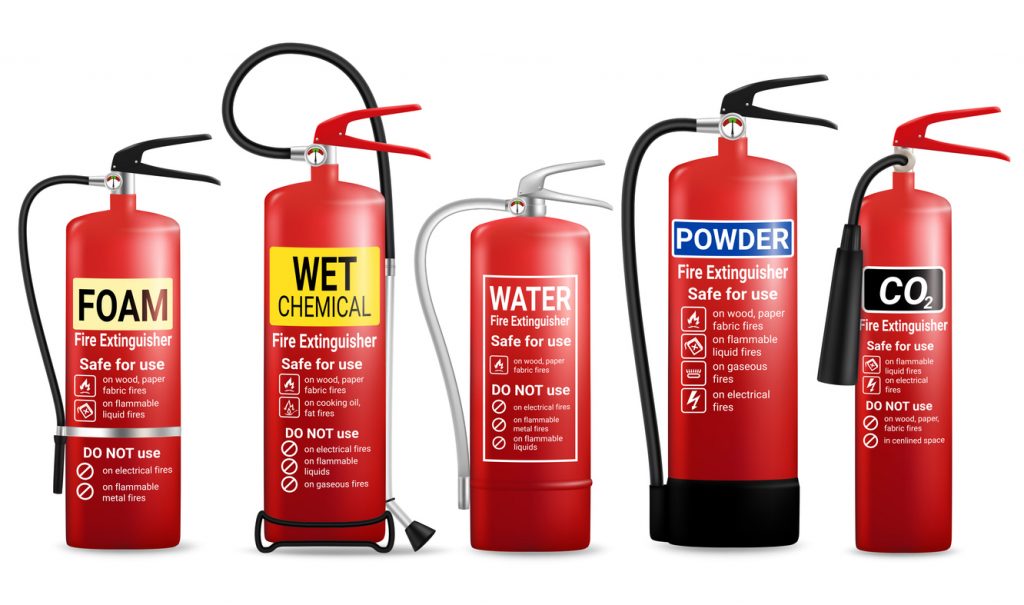"BLOG"
Fire Extinguisher Types: A Comprehensive Guide to Choosing the Right Weapon for the Fight
Fire extinguishers are the first line of defense against a potentially devastating fire. But with a variety of fire extinguisher types available, selecting the right one can feel overwhelming. This in-depth blog post delves into the world of fire extinguishers, equipping you with the knowledge to make an informed decision and ensure you have the most effective weapon for the fight.
Understanding Fire Classification: The Core of Choosing the Right Extinguisher
Before exploring fire extinguisher types, it's crucial to grasp the fire classification system. This system categorizes fires based on the fuel source, dictating the appropriate extinguisher for each type. Here's a breakdown of the common fire classifications:

Class A:
Ordinary Combustibles (Solid Materials) - This category encompasses fires fueled by ordinary combustible materials like paper, wood, textiles, and plastics.
Class B:
Flammable Liquids - These fires involve flammable liquids such as gasoline, oil, grease, kerosene, paint, and solvents.
Class C:
Flammable Gases - This classification covers fires fueled by flammable gases like propane, methane, butane, and natural gas
Class D:
Combustible Metals - Fires involving combustible metals like magnesium, lithium, sodium, and potassium fall under Class D.
Class E:
Electrical Fires - Energized electrical equipment fires are classified as Class E.
Class F:
Cooking Oils - Fires involving fats and oils used for cooking are designated as Class F.
Fire Extinguisher Types: Unveiling the Arsenal Now that we've established the fire classification system, let's delve into the different fire extinguisher types and their functionalities:
Water Fire Extinguishers (Class A):
Functioning: Water extinguishers, the most recognizable type, employ pressurized water to extinguish fires. The water stream cools the burning materials, effectively dousing Class A fires.
Applications: Due to their effectiveness against ordinary combustibles, water extinguishers are ideal for homes, offices, and general use. Limitations: Water is highly conductive and can worsen electrical fires (Class E) and fires involving flammable liquids (Class B) by spreading the burning liquid. Additionally, water can damage electronics and sensitive equipment. Water extinguishers are not recommended for use on Class C (flammable gas), Class D (combustible metal), or Class F (cooking oil) fires.
Foam Fire Extinguishers (Class A & B):
Functioning: Foam extinguishers discharge a foam blanket that smothers Class A fires (ordinary combustibles) by excluding oxygen. They are also effective against Class B (flammable liquid) fires by blanketing the burning liquid and preventing the vapors from reaching their ignition source.
Applications: Foam extinguishers are versatile choices for environments with potential Class A and B fire risks, such as workshops, garages, and kitchens where flammable liquids are used. They are particularly useful for flammable liquid fires as they don't spread the burning liquid like water extinguishers.
Limitations: Foam can leave behind a slippery residue, requiring cleanup after use. Using the wrong type of foam for a specific flammable liquid can be ineffective. Additionally, foam extinguishers may not be suitable for use in extreme cold or hot environments.
Carbon Dioxide (CO2) Fire Extinguishers (Class B & C):
Functioning: CO2 extinguishers utilize pressurized carbon dioxide gas to extinguish fires. The CO2 gas displaces oxygen, suffocating Class B (flammable liquids) and Class C (flammable gas) fires.
Applications: CO2 extinguishers are suitable for use in office environments with electronic equipment due to their non-conductive properties and minimal residue. They are also effective in confined spaces due to their ability to extinguish fires without displacing a large amount of air.
Limitations: CO2 extinguishers have a short throw distance, limiting their effectiveness in larger spaces. The CO2 gas can cause rapid cooling, potentially creating thermal shock that could shatter glass or freeze pipes. Additionally, CO2 can displace oxygen, posing a risk of suffocation in confined spaces if not used with proper ventilation. They leave no residual extinguishing agent and may not be effective on deep-seated fires or those involving solid materials (Class A).
Dry Chemical Powder Fire Extinguishers (Multi-Purpose):
Functioning: Dry chemical powder extinguishers are labeled for Class A, B, and C fires. The extinguisher expels a fine, dry chemical powder that disrupts the chemical reaction of the fire, extinguishing it.
Applications: Due to their versatility, dry chemical powder extinguishers are popular choices for various environments, including homes, offices, and industrial settings.
All Service, Maintenance, and Inspection of Fire Sprinkler Systems MUST be handled by a licensed Professional. THAT'S US!











